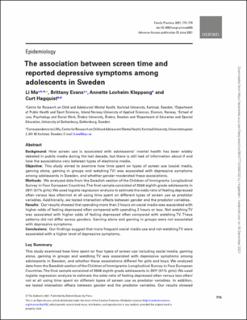The association between screen time and reported depressive symptoms among adolescents in Sweden
Peer reviewed, Journal article
Published version
Permanent lenke
https://hdl.handle.net/11250/2833046Utgivelsesdato
2021Metadata
Vis full innførselSamlinger
Originalversjon
10.1093/fampra/cmab029Sammendrag
Background How screen use is associated with adolescents’ mental health has been widely debated in public media during the last decade, but there is still lack of information about if and how the associations vary between types of electronic media. Objective This study aimed to examine how time spent on types of screen use (social media, gaming alone, gaming in groups and watching TV) was associated with depressive symptoms among adolescents in Sweden, and whether gender moderated these associations. Methods We analysed data from the Swedish section of the Children of Immigrants: Longitudinal Survey in Four European Countries. The final sample consisted of 3556 eighth grade adolescents in 2011 (51% girls). We used logistic regression analysis to estimate the odds ratio of feeling depressed often versus less often/not at all using time spent on different types of screen use as predictor variables. Additionally, we tested interaction effects between gender and the predictor variables. Results Our results showed that spending more than 2 hours on social media was associated with higher odds of feeling depressed often compared with spending 2 hours or less. Not watching TV was associated with higher odds of feeling depressed often compared with watching TV. These patterns did not differ across genders. Gaming alone and gaming in groups were not associated with depressive symptoms. Conclusions Our findings suggest that more frequent social media use and not watching TV were associated with a higher level of depressive symptoms.

